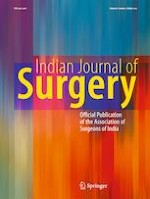Erschienen in:

23.02.2020 | Original Article
Characteristics of Subcutaneous Drainage Fluid in Patients After Hepatopancreatobiliary Surgery
verfasst von:
Lei Gong, Bin Shu, Xin Huang, Xiaobin Feng
Erschienen in:
Indian Journal of Surgery
|
Ausgabe 5/2020
Einloggen, um Zugang zu erhalten
Abstract
The beneficial effect of subcutaneous drainage has been challenged. Here, we evaluated subcutaneous drainage fluid characteristics in patients without complications after hepatopancreatobiliary surgery. We aimed to provide useful information for addressing this issue. We included 59 patients that underwent hepatopancreatobiliary surgery for hepatic (n = 33), biliary (n = 12), and pancreatic (n = 14) disorders. We recorded the total volume of drainage liquid. We analyzed drainage fluid characteristics (biochemical test, cells, etc.) and patient demographic and clinical characteristics. Differences in characteristics were assessed among hepatic, biliary, and pancreatic surgery groups. Pearson correlation coefficient analyses were performed to assess associations between preoperative parameters and drainage volume. The median body mass index was 24.01 kg/m2. The mean blood loss and operation time were 371 ml and 406 min, respectively. Three (5.1%) patients required transfusions. The median drainage fluid volume was 37.34 ml, and the median density was 1.0217. The total numbers of white and red blood cells were 4.38*105/L and 30.5*103/L, respectively. The protein, glucose, and adenosine deaminase contents were 34.41 g/L, 1.22 mmol/L, and 103.09 U/L, respectively. The Rivalta test and lactate dehydrogenase were positive in 14 (77.8%) and 16 (88.9%) patients, respectively. All parameters were similar between the three surgical groups. Preoperative erythrocyte and hemoglobin levels were weakly positively correlated with subcutaneous drainage fluid volumes. We found a substantial amount of protein in subcutaneous drainage fluid. Removing the fluid might reduce the risks of incision fat liquefaction and infection. At minimum, subcutaneous drainage reduced the frequency of incisional dressing changes.